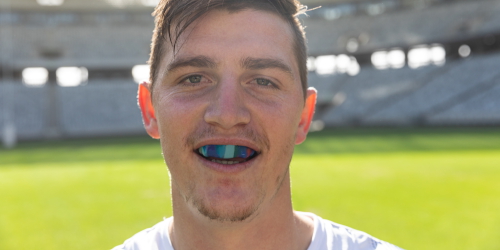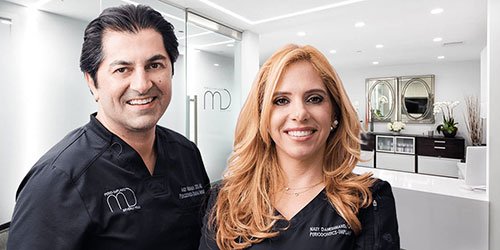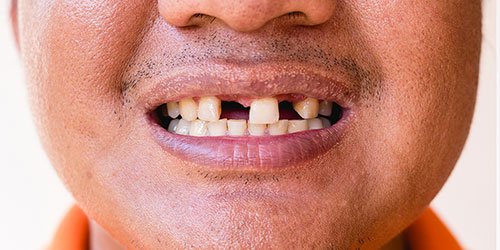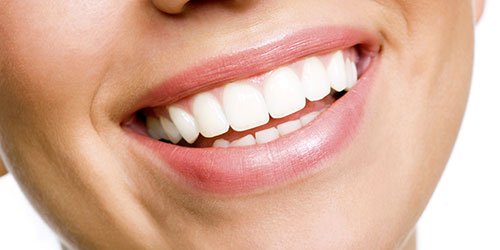What is dental bone grafting?
Bone grafting is a surgical procedure used in dentistry that involves adding bone or bone-like material into segments of the jaw that have inadequate bone quantity or quality. It is done in order to create a solid foundation upon which a restorative tooth can be mounted.

The bone grafting procedure is a minor surgery and is therefore performed in our office using light sedation.
When teeth are lost due to trauma, gum disease, or tooth decay, the jawbone socket in which they were located begins to collapse (or “resorb”). This is because one of the functions of a healthy tooth is to stimulate the underlying jawbone (in either the lower or upper jaw) and surrounding tissues.
If teeth are lost and not replaced, the underlying jawbone begins to resorb, neighboring teeth will shift toward the empty socket, and your face will begin to sag as your jawbone shrinks because there is not enough bone. This greatly complicates treatment to replace missing teeth.
Luckily, modern bone grafting techniques allow your periodontist to help spur bone growth to rebuild and strengthen the lost jawbone segment. This makes it possible to place dental implants and restore your facial integrity.
Why would someone need a dental bone graft?
There are numerous reasons for needing a dental bone graft, including:
Saving teeth
When severe gum disease results in bone resorption that causes a tooth to come loose, it might be necessary to support the loose tooth by regenerating the surrounding bone using a bone graft.
Preserving bone around an empty tooth socket

Socket preservations preserve the bone around an empty tooth socket after tooth loss or extraction. We usually place the bone graft at the same time the tooth is extracted to reduce the number of procedures for our patients.
It is common practice to deposit bone graft material into an empty tooth socket after the tooth extraction. This procedure, known as ridge preservation, is done to preserve the underlying jawbone ridge.

Dental implants placement
A dental implant procedure is the best available tooth-replacement system there is. It involves permanently inserting an artificial tooth into your jawbone. How? A small screw-like post made of titanium or ceramic is embedded into your jawbone where your missing tooth was previously located and a realistic-looking porcelain crown designed to match your natural teeth is later fitted on top of this post.
Implants require good underlying jawbone volume and density to support the stem and ensure the proper function of the implanted tooth. If you have already experienced significant bone loss in your jaw ridge, your periodontist might recommend a graft in order to create a solid bone foundation for the implant to succeed. This procedure, known as ridge augmentation, increases the width of the alveolar ridge to make space for implants.
Sinus Lift
Sometimes for proper implant placement, a sinus lift is necessary. This procedure adds bone above the upper molars to make sure the sinus membrane wall that divides the maxillary sinuses and the oral cavity is thick enough for implant placement.
What materials are used for dental bone grafting procedures?
Several types of organic and synthetic materials are used today for bone regeneration. For instance, the graft material can be existing bone tissue that comes from your own body (known as an autograft or allograft) or from human cadavers or animal donor bone that has been specially treated in a lab to make it sterile and safe.
There is also synthetic bone material with properties similar to real bone that’s used for grafting. Grafting material comes in a variety of forms: from powder to granules, putty, and even gel that can be injected into tiny areas using a syringe.
Luckily, modern bone grafting techniques allow your periodontist to help spur bone growth
How is dental bone grafting done?
The procedure for placing a bone graft typically requires just local anesthesia, although some patients might prefer to receive oral or intravenous sedation to help them become even more relaxed.
After anesthesia has taken effect, your periodontist makes an incision in your gum to gain access to the supporting jaw bone (referred to as the dental ridge) and then places graft material into the socket hole created by your missing tooth.

After the graft material is inserted, the area is protected with the placement of a collagen membrane that supports bone healing. The graft material will act as scaffolding upon which your body will add new bone cells to fill in the gap.
What to expect after a dental bone graft procedure
Because a small incision is made in your gum tissue to get access to the area where the graft material will be placed, you may experience some post-op soreness in that area. This is usually managed with over-the-counter anti-inflammatories and/or pain relievers and ice chips. Luckily, for most patients, this discomfort lasts only a day or two.
During the three months following a bone graft, your body will gradually replace the graft material with your own bone, increasing the bone density at the graft site.
Why choose MD Periodontics for dental bone grafting?
Dr. Abdy Moshrefi and Dr. Nazanin Daneshmand know that a successful bone graft builds a healthy foundation for not just a beautiful smile but lasting oral health by avoiding periodontal disease.

This board-certified husband and wife team has a hard-earned reputation for performing some of the best dental bone grafting Los Angeles has to offer.
Your dental care takes place in a state-of-the-art facility that’s conveniently located in Beverly Hills. Our professional and highly experienced staff ALWAYS makes sure that all your questions are answered and that you are comfortable throughout your treatment. We also diligently follow up with you after your procedure to keep a close watch on your progress and ensure that you are doing well.
To schedule an appointment, click here or call (310) 859-9449. Your smile will thank you!
We have convenient accessibility for patients throughout Southern California and the Los Angeles area. Our Beverly Hills office is conveniently located near West Los Angeles, Culver City, West Hollywood, Downtown Los Angeles, Marina del Rey, Pacific Palisades, Malibu, Manhattan Beach, Sherman Oaks, and Encino.
 (310) 859-9449
(310) 859-9449 Bone Grafting
Bone Grafting
 or call us at
or call us at 















































